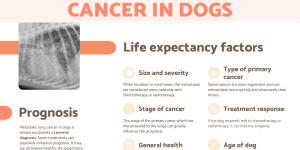Hemangiosarcoma in Dogs



See files for Dogs
Hemangiosarcoma is one of the types of soft tissue neoplasms (cancer) most feared by dog handlers. Hemangiosarcoma is a common cancer in dogs and accounts for about 5% of cases. Because blood vessels run throughout the body, hemangiosarcoma can develop anywhere. It is extremely invasive and metastatic and can affect any vascular organ. The aggressiveness of hemangiosarcoma is due to the rapid spread of tumor cells by a hematogenous route, with the most common site of origin being the spleen.
The following AnimalWised article explains what hemangiosarcoma in dogs is, its symptoms, treatments, and life expectancy.
What is hemangiosarcoma in dogs?
Hemangiosarcoma is a malignant tumor that originates from the cells lining the blood vessels. It is considered a malignant, aggressive tumor that can affect various organs and form regional or distant metastases. These tumors are typically filled with blood and very fragile.
Due to its biological behavior with a high rate of hematogenous or lymphatic spread due to tumor emboli, approximately 80% of animals already have metastases at the time of diagnosis. The dog is the most commonly affected pet that dies or is euthanized from the disease.
The primary location is usually the spleen, but the visceral form of the disease can affect other organs, such as the tongue, conjunctiva, liver, lungs, chest, pericardium, right atrium, aorta, lungs, etc., kidneys, muscles, bones, intestines, gallbladder, urinary tract, prostate, vagina, and peritoneum. This form of hemangiosarcoma is the most common. Although the etiology is unknown, several factors such as genetics, sun exposure, and lack of control of angiogenesis (formation of new blood vessels) are known to play a role.
Although less common, hemangiosarcoma can also manifest cutaneously, as a primary or metastatic site, and it can affect the dermis and subcutaneous tissues, with a predilection for the skin of the abdomen, prepuce, and pelvic limbs.
In this sense, short-haired or poorly pigmented dogs are more susceptible to excessive UV irradiation, which triggers the primary variant of the disease. However, cutaneous hemangiosarcoma in dogs is less aggressive than visceral hemangiosarcoma and has a lower metastatic potential.
You may also be interested in this other article, where we talk about the most common skin tumors in dogs.

Causes of Hemangiosarcoma in Dogs
The etiology of hemangiosarcomas is still not fully understood. However, several causes are considered, such as genetic predisposition, chemical exposure, ionizing radiation, oncogenic viruses, administration of vaccines or drugs.
Some studies suggest that prolonged exposure of dogs to cigarette smoke may contribute to the development of the disease, as nicotine increases proliferation of primitive endothelial cells in various models of angiogenesis.
Symptoms of Hemangiosarcoma in Dogs
The clinical signs exhibited by a dog with hemangiosarcoma are usually related to the site of origin of the primary tumor and the presence of metastases.
In the event of rupture of the neoplasm, the animal may present with severe internal hemorrhage. Internal hemorrhages are perceived by the caregiver by the appearance of abdominal distension and manifestations associated with acute hemorrhage, primarily:
- Pale mucous membranes
- Tachycardia
- Tachypnea
The dog might also experience other less common associated symptoms, such as:
- Lethargy
- Depression
- Anorexia
- Weight loss
- Palpable abdominal mass
- Exercise intolerance
If the bleeding is too acute, it can lead to death from hypovolemic shock, which is death from loss of large amounts of fluid and blood.
Primary hemangiosarcomas in bones are quite rare, with an incidence of less than 5%. Long bones such as humerus, femur, ribs, and vertebrae are often affected. The most common symptoms are fractures at these sites.
Cutaneous hemangiosarcomas in dogs occur most commonly in the ventral abdominal region, back, head, neck, and scapular, axillary, inguinal, and medial femoral (inner thigh) regions. The most common symptoms are: nodular tumors or masses of reddish color and firm consistency.

Diagnosis of Hemangiosarcoma in Dogs
Veterinarians may suspect hemangiosarcoma based on clinical signs and history. The testing and diagnosis of hemangiosarcoma varies from case to case because any body system can be affected.
Generally, patients with hemangiosarcoma are not diagnosed until the tumor has reached a reasonable size because clinical signs are nonspecific.
Veterinarians usually recommend blood tests, chest radiographs, abdominal ultrasounds, and cardiac echocardiograms when hemangiosarcoma is suspected. Advanced imaging studies such as CT or MRI can help determine the extent of the spread of the disease. The final diagnosis of hemangiosarcoma is made by histopathologic examination (biopsy or excision of the tumor).
Treatment for Hemangiosarcoma in Dogs
Treatment of hemangiosarcoma is based on staging, i.e., stage of tumor development, lymph node involvement, and presence of metastases.
Complete removal of the primary tumor is the main goal of treatment to achieve a higher cure rate. However, first the animal must be stabilized before shock, blood tests must be carefully evaluated, and coagulation abnormalities must be corrected. Surgery must be performed to remove all affected tissue, especially in cutaneous hemangiosarcomas.
Unfortunately, due to the rapid development of metastases, surgical intervention usually has no effect on the life expectancy of the affected animal, and chemotherapy and immunotherapy must be administered.
Chemotherapy can prolong the life of dogs. It is a palliative therapy aimed at remission and/or well-being of the animal, improving its quality of life and alleviating the symptoms of metastases or tumors that can no longer be operated on.
Acupuncture, in combination with other treatment techniques such as those mentioned, has shown satisfactory results in improving the animal's well-being, delaying the development of cancer and increasing life expectancy, as well as promoting the restoration of balance in the organism. In any case, it is the treating veterinarian who decides whether this type of treatment is useful or not depending on each individual.

Life expectancy of a dog with hemangiosacroma
The life expectancy of a dog suffering from hemangiosarcoma varies widely and depends on factors such as the characteristics of the dog, the size of the tumor, operability, the presence of metastases, and the organs involved. The earlier the diagnosis is made, the better the chances of treatment and the longer the dog's survival.
Now that you know what canine hemangiosarcoma is, what its symptoms are and what its consequences are, do not hesitate to go to the vet if you notice any warning signs. Remember that fast action is crucial in this pathology.
This article is purely informative. AnimalWised does not have the authority to prescribe any veterinary treatment or create a diagnosis. We invite you to take your pet to the veterinarian if they are suffering from any condition or pain.
If you want to read similar articles to Hemangiosarcoma in Dogs, we recommend you visit our Degenerative diseases category.
- Martins, KP; Almeida, C.B.; Gomes, DE Canine Hemangiossarcoma . Scientific Magazine, v.1, n.1, 2019. Available at: https://revistas.unilago.edu.br/index.php/revista-cientifica/article/view/202. Accessed on: 09/09/2022.
- Pinto, MPR Canine multicentric hemangiossarcoma: case report . Federal University of Bahia, 2015. Available at: https://repositorio.ufba.br/bitstream/ri/19608/1/Hemangiossarcoma%20Multic%C3%AAntrico%20Canino%20-%20Relato%20de%20caso%20-% 20Marcela%20Pr%C3%B3spero%20Rodrigues%20Pinto.pdf. Accessed on 09/09/2022.
- Freitas, J.; Yi, LC; Forlani, G.S. (2019). Canine hemangiossarcoma: review . PubVet, v.13, n.8. Available at: file:///C:/Users/carlamoreira/Downloads/hemangiosarcoma-canino-revisatildeo.pdf. Accessed on: 09/09/2022.
- Soares, NP et al . (2017). Hemangiomas and hemangiossarcomas in cães: retrospective study of 192 cases (2002-2014) . Science. anime Bras., v.18. Available at: https://www.scielo.br/j/cab/a/hcqtgbm5LrTyFTyHb7CtRRj/?lang=pt&format=pdf. Accessed on 09/09/2022.








